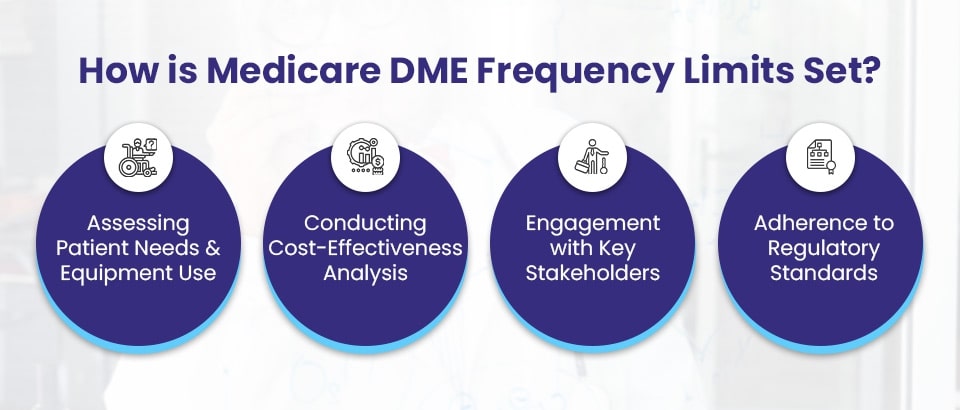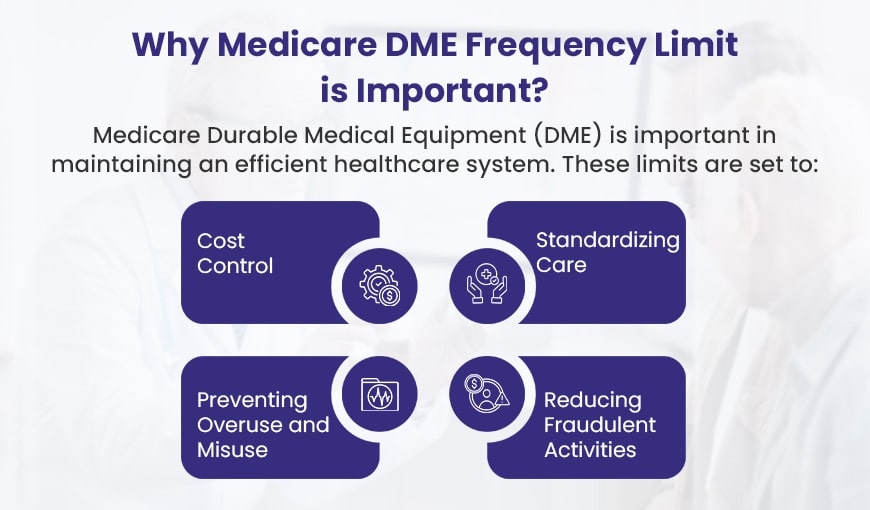Key Takeaways:
Medicare has limits on how often you can get durable medical equipment (DME). The limits depend on the item. It may be 1 month, 6 months, 12 months, or 5 years between getting the same item.
The 2025 limits look a lot like past years. So Medicare’s DME rules seem stable.
Aside from frequency limits, Medicare continues to cover DME when medically necessary and prescribed by practitioners.
As 2025 unfolds, healthcare providers are struggling with a rising wave of claim denials for Durable Medical Equipment (DME). The culprit? Medicare’s opaque frequency limits that dictate DME replacement periods. For providers, this translates to clogged operations and patients left waiting.
But there’s hope on the horizon. Developing expertise in Medicare’s frequency limit nuances is the antidote providers need. With this knowledge, they can comply with requirements, streamline DME delivery, and slash denials.
This blog offers providers a detailed decode of Medicare’s complex frequency rules. Consider it your insider’s guide to seamlessly supplying DME on time, without getting ensnared in Medicare’s red tape. Armed with these insights, providers can meet patient needs promptly and painlessly while keeping denials at bay.
What is meant by Medicare’s “DME Frequency Limits?
Medicare DME frequency limits refer to guidelines determining how often Medicare will cover replacement durable medical equipment (DME) for a beneficiary.
For example, Medicare may allow a new wheelchair every 5 years, a new walker every 3 years, or new diabetic test strips every month. These limits enable Medicare to manage costs and prevent overutilization of equipment.
However, the frequency limits also ensure beneficiaries have access to essential DME on a reasonable replacement schedule. With frequency limits, patients can receive new DME when truly needed, while Medicare can control excessive spending.
👉 Let me break down this thing for you in more simplified terms:
Think of Medicare DME Frequency Limits as the “replacement schedule” for your medical equipment and supplies. Just like you wouldn’t keep using the same toothbrush for years on end, Medicare has rules about how often certain items should be replaced or resupplied.
For instance, if you use a CPAP machine for sleep apnea, Medicare might allow you to get a new mask and tubing every three months since those components can wear out and need to be refreshed regularly. On the other hand, if you have a wheelchair, Medicare might only allow you to get a brand new one every five years or so, since wheelchairs are built to last longer with proper maintenance.
These limits are designed to keep you safe and healthy by ensuring you have access to well-maintained, functional equipment while also preventing excessive waste and controlling costs. They strike a balance between your medical needs and responsible resource management.
⭐ GET IN TOUCH
Outsource DME Billing Now
Cut denials by 40% and boost cash flow with certified billers who specialize only in DME billing services. We manage everything from HCPCS coding to real-time AR follow-up.
Understanding Medicare DME Frequency Limits
➜ Medicare has limits on how often it will cover the replacement of Durable Medical Equipment (DME) such as wheelchairs, walkers, and hospital beds.
➜ These limits are based on the equipment’s Reasonable Useful Lifetime (RUL). The RUL is the expected lifespan of the equipment, calculated from the date it was issued to the beneficiary, not the manufacturing date.
➜ Medicare will typically cover a replacement after the RUL has expired or if the equipment is lost, stolen, or damaged beyond repair.
➜ In some cases, Medicare’s frequency limits can be overridden with proper authorization from your healthcare provider. This may involve submitting:
- Service Authorization Request (SAR) – a request for approval of a particular service or item.
- Treatment Authorization Request (TAR) – a request for approval of a course of treatment.
➜ Your healthcare provider can guide you through the process of obtaining necessary authorizations if your situation warrants an exception to the standard frequency limits.
The following is a table of the specific Medicare frequency limits that have been established for a variety of durable medical equipment (DME). We have grouped the frequency limits based on how long they last. For instance, some items can only be replaced once a month, while others can be replaced only once every few years.
| HCPCS Code | Frequency Limit | HCPCS Description |
| A4226 | 1 per week | Supplies for external insulin infusion pump, per month |
| A4271 | 1 per month | Integrated lancet device, each |
| A7021 | 1 per month | Replacement nasal interface (mask or cannula type) for PAP device |
| A7028 | 1 per month | Replacement oral cushion for combination oral/nasal PAP mask |
| A7029 | 2 (pair) per month | Replacement nasal pillows for combination oral/nasal PAP mask, pair |
| A7032 | 1 per month | Replacement nasal cushion for PAP mask |
| A7033 | 2 pairs per month | Replacement nasal pillows for PAP interface, pair |
| A7038 | 2 per month | Disposable filter for PAP device |
| A7048 | 1 per month | Exhalation port with or without swivel, used with respiratory therapy accessories |
| E0441 | 1 per month | Oxygen contents, gaseous, 1 month’s supply |
| E0442 | 1 per month | Oxygen contents, liquid, 1 month’s supply |
| E0443 | 2 per month | Portable oxygen contents, gaseous, 1 month’s supply |
| E0444 | 2 per month | Portable oxygen contents, liquid, 1 month’s supply |
| A4619 | 1 in 3 months | Face tent for respiratory therapy |
| A4620 | 1 in 3 months | Variable concentration mask for oxygen therapy |
| A7049 | 1 in 3 years | Replacement oral interface for PAP therapy |
| E0156 | 1 in 3 years | Seat attachment for walker |
| E0167 | 1 in 3 years | Replacement pail or pan for commode chair |
| E0199 | 1 in 12 months | Water circulating heat pad with pump |
| A4602 | 1 in 6 months | Replacement battery for external infusion pump, lithium |
| A4604 | 1 in 6 months | Heated tubing for PAP device |
| A4606 | 6 per month | Oxygen probe replacement for oximeter device |
| A7015 | 3 per month | Aerosol mask used with DME nebulizer |
| A7020 | 1 in 6 months | Replacement interface for cough stimulating device |
| A7001 | 1 in 6 months | Non-disposable nebulizer, replacement |
| A7005 | 1 in 6 months | Administration set with small volume non-filtered pneumatic nebulizer, non-disposable |
| A7034 | 1 in 6 months | Nasal interface (mask or cannula type) used with PAP device, with or without head strap |
| A7035 | 1 in 6 months | Headgear used with PAP device |
| A7036 | 1 in 6 months | Chinstrap used with PAP device |
| A7037 | 1 in 6 months | Tubing used with PAP device |
| A7039 | 1 in 6 months | Non-disposable filter used with PAP device |
| A7044 | 1 in 6 months | Oral interface used with PAP device |
| A4281 | 2 in 12 months | Replacement tubing for breast pump |
| A4282 | 2 in 12 months | Replacement adapter for breast pump |
| A4283 | 2 in 12 months | Replacement cap for breast pump bottle |
| A4284 | 2 in 12 months | Replacement breast shield and splash protector for breast pump |
| A4285 | 2 in 12 months | Replacement polycarbonate bottle for breast pump |
| A4286 | 2 in 12 months | Replacement locking ring for breast pump |
| A4287 | 120 per infant | Breast milk storage bags, any size, per 50 |
| A4555 | 2 per month | Electrodes/transducers for electrical stimulation device, per pair |
| A4556 | 4 pair per month | Electrodes (e.g., apnea monitor), per pair |
| A4557 | 1 pair in 12 months | Lead wires (e.g., apnea monitor), per pair |
| A4635 | 2 in 12 months | Replacement underarm pad for crutch, each |
| A4636 | 2 in 12 months | Replacement handgrip for cane, crutch, or walker, each |
| A4637 | 8 in 12 months | Replacement tip for cane, crutch, or walker, each |
| A4640 | 1 in 12 months | Replacement pad for infrared heating pad system, each |
| A7030 | 1 in 12 months | Full face mask used with PAP device, each |
| A7031 | 1 in 12 months | Replacement cushion for full face mask |
| A7027 | 1 in 12 months | Combination oral/nasal mask used with PAP device, each |
| E0199 | 1 in 12 months | Water circulating heat pad with pump |
| E9284 | 1 in 12 months | Accessible phone for the hearing impaired |
| A7049 | 1 in 3 years | Replacement oral interface for PAP therapy |
| E0156 | 1 in 3 years | Seat attachment for walker |
| E0167 | 1 in 3 years | Replacement pail or pan for commode chair |
| A4566 | 1 in 5 years | Shoulder sling or vest design, abduction restrainer |
| A4660 | 1 in 5 years | Sphygmomanometer/blood pressure apparatus with cuff and stethoscope |
| A4663 | 1 in 5 years | Blood pressure cuff only |
| A4670 | 1 in 5 years | Automatic blood pressure monitor |
| E0100 | 1 in 5 years | Cane, includes canes of all materials, adjustable or fixed, with tip |
| E0105 | 1 in 5 years | Cane, quad or three prong, includes canes of all materials, adjustable or fixed, with tips |
| E0110 | 1 in 5 years | Crutches, forearm, adjustable or fixed, with tips and handgrips, pair |
| E0112 | 1 in 5 years | Crutches, underarm, wood, adjustable or fixed, pair, with pads, tips, and handgrips |
| E0114 | 1 in 5 years | Crutches, underarm, non-wood, adjustable or fixed, pair, with pads, tips, and handgrips |
| E0117 | 1 in 5 years | Crutch, underarm, articulating, spring-assisted, each |
| E0130 | 1 in 5 years | Rigid (pick-up) walker, adjustable or fixed height |
| E0135 | 1 in 5 years | Folding (pick-up) walker, adjustable or fixed height |
| E0140 | 1 in 5 years | Walker with trunk support, adjustable or fixed height |
| E0141 | 1 in 5 years | Rigid walker, wheeled, adjustable or fixed height |
| E0143 | 1 in 5 years | Folding walker, wheeled |
| E0144 | 1 in 5 years | Walker, enclosed, four-sided framed, rigid or folding, wheeled with posterior seat |
| E0147 | 1 in 5 years | Walker, heavy-duty, multiple braking system, variable wheel resistance |
| E0148 | 1 in 5 years | Walker, heavy-duty, without wheels, rigid or folding, any type, each |
| E0149 | 1 in 5 years | Walker, heavy-duty, wheeled, rigid or folding, any type |
| E0153 | 2 in 5 years | Platform attachment for forearm crutch, each |
| E0154 | 2 in 5 years | Platform attachment for walker, each |
| E0155 | 1 in 5 years | Wheel attachment for rigid pick-up walker, per pair |
| E0157 | 1 in 5 years | Crutch attachment for walker, each |
| E0158 | 1 in 5 years | Leg extensions for walker, per set of four |
| E0159 | 2 in 5 years | Brake attachment for wheeled walker, replacement, each |
| E0163 | 1 in 5 years | Commode chair with fixed arms |
| E0165 | 1 in 5 years | Commode chair, mobile or stationary, with detachable arms |
| E0168 | 1 in 5 years | Commode chair, extra wide and/or heavy duty, stationary or mobile, with or without arms |
| E0170 | 1 in 5 years | Commode chair with integrated seat lift mechanism |
| E0171 | 1 in 5 years | Commode chair with seat lift mechanism, electric |
| E0181 | 1 in 5 years | Pressure pad for mattress |
| E0182 | 1 in 5 years | Pump for alternating pressure pad |
| E0184 | 1 in 5 years | Dry pressure pad for mattress |
| E0185 | 1 in 5 years | Gel or gel-like pressure mattress pad |
| E0186 | 1 in 5 years | Air pressure pad for mattress |
| E0187 | 1 in 5 years | Water pressure pad for mattress |
| E0193 | 1 in 5 years | Powered air flotation bed |
| E0194 | 1 in 5 years | Air-fluidized bed |
| E0196 | 1 in 5 years | Gel pressure mattress |
| E0197 | 1 in 5 years | Air pressure mattress |
| E0198 | 1 in 5 years | Water pressure mattress |
| E0202 | Once per lifetime | Phototherapy light with eye shield |
| E0210 | 1 in 5 years | Electric heating pad, standard size |
| E0240 | 1 in 5 years | Bath/shower chair, with or without wheels, any type |
| E0241 | 2 in 5 years | Bath tub wall rail, each |
| E0242 | 1 in 5 years | Bath/shower chair with or without wheels |
| E0243 | 1 in 5 years | Toilet rail, each |
| E0244 | 1 in 5 years | Raised toilet seat |
| E0245 | 1 in 5 years | Tub stool or bench |
| E0246 | 1 in 5 years | Transfer tub rail attachment |
| E0247 | 1 in 5 years | Transfer bench for tub or toilet with or without commode opening |
| E0248 | 1 in 5 years | Bath/shower chair with or without wheels, with commode opening |
| E0271 | 1 in 5 years | Mattress, innerspring |
| E0272 | 1 in 5 years | Mattress, foam rubber |
| E0273 | 1 in 5 years | Bed board |
| E0277 | 1 in 5 years | Powered pressure-reducing air mattress |
| E0291 | 1 in 5 years | Hospital bed, fixed height, with any type side rails, with mattress |
| E0293 | 1 in 5 years | Hospital bed, variable height, with any type side rails, with mattress |
| E0295 | 1 in 5 years | Hospital bed, semi-electric (head and foot adjustment), with any type side rails, with mattress |
| E0297 | 1 in 5 years | Hospital bed, total electric (head, foot, and height adjustments), with any type side rails, with mattress |
| E0300 | 1 in 5 years | Pediatric crib, hospital grade, fully enclosed, with or without top enclosure |
| E0303 | 1 in 5 years | Hospital bed, heavy-duty, extra wide, with any type side rails, without mattress |
| E0304 | 1 in 5 years | Hospital bed, extra heavy-duty, extra wide, with any type side rails, without mattress |
| E0305 | 1 in 5 years | Bed side rails, half length |
| E0310 | 1 in 5 years | Bed side rails, full length |
| E0316 | 1 in 5 years | Safety enclosure frame/canopy for use with hospital bed, any type |
| E0328 | 1 in 5 years | Hospital bed, pediatric, manual, 360-degree side enclosures, top mounted, with or without mattress |
| E0329 | 1 in 5 years | Hospital bed, pediatric, electric or semi-electric, 360-degree side enclosures, top mounted, with or without mattress |
| E0350 | 1 in 5 years | Control unit for electric osteogenesis stimulator |
| E0371 | 1 in 5 years | Non-powered advanced pressure reducing overlay for mattress, standard mattress length and width |
| E0372 | 1 in 5 years | Powered air overlay for mattress, standard mattress length and width |
| E0373 | 1 in 5 years | Non-powered advanced pressure reducing mattress |
| E0425 | 1 in 5 years | Stationary compressed gaseous oxygen system, rental; includes container, contents, regulator, flowmeter, humidifier, nebulizer, cannula or mask, and tubing |
| E0430 | 1 in 5 years | Portable gaseous oxygen system, purchase; includes regulator, flowmeter, humidifier, cannula or mask, and tubing |
| E0435 | 1 in 5 years | Portable liquid oxygen system, rental; home liquefier used to fill portable liquid oxygen containers, includes portable containers, regulator, flowmeter, humidifier, cannula or mask, and tubing |
| E0440 | 1 in 5 years | Oxygen contents, gaseous, per unit |
| E0455 | 1 in 5 years | Oxygen tent, excluding croup or pediatric tents |
How are the limits for Medicare DME set?
Medicare DME has rules about how often you can get things. These rules help make sure patients get what they need and that costs stay manageable. There are a few things that help decide these limits. Let’s look at each one that helps Medicare figure out the DME frequencies:

Assessing Patient Needs and Equipment Usage
Medicare sets frequency limits for DME by closely analyzing patient needs and equipment usage. This process involves reviewing medical records and claims data to understand how often equipment requires replacement for different conditions. Medicare examines factors like expected equipment life spans, how deterioration occurs with use, and the level of support needed by patients over time.
By gathering data on real-world equipment use, Medicare can establish reasonable limits on replacement frequency. This makes sure patients get the DME they need, without getting too much and wasting it.
Conducting Cost-Effectiveness Analysis
Medicare carefully checks how much things cost to keep the program running with financial stability. These analyses give Medicare a comprehensive understanding of the costs of providing and replacing Durable Medical Equipment (DME) versus the benefits this equipment provides to patients.
The analyses look at factors like how much it costs to buy and take care of equipment over time and how much better it makes people’s health. They also consider if less expensive alternatives could provide similar benefits.
By weighing all these factors, Medicare looks at all these things to make sure it saves money while still helping patients with their health needs.
Engaging with Key Stakeholders
Medicare recognizes the importance of a collaborative approach when setting DME frequency limits. Therefore, Medicare engages with different stakeholders to make sure the rules are easy to follow, make sense for health care, and fit what everyone needs.
To do this, Medicare talks with doctors, medical equipment makers, and patient advocacy groups. Doctors and nurses know a lot about taking care of patients. They understand what is needed for medical equipment to help people feel better. Manufacturers, on the other hand, contribute their expertise on the latest advancements in DME technology, ensuring that the limits are compatible with the available products and innovations.
Crucially, Medicare also seeks input from patient advocacy groups, ensuring that the patient’s perspective is at the forefront of the decision-making process. These groups share important stories about what patients go through. They help create rules that focus on keeping patients happy and healthy.
By encouraging this collaborative atmosphere, Medicare may strike a balance between cost-effectiveness and patient care, ensuring that frequency limits are neither overly strict nor unnecessarily lenient.
Adherence to Regulatory Standards
The Centers for Medicare & Medicaid Services (CMS), the federal agency responsible for administering the Medicare program, works closely with various regulatory bodies, including the Food and Drug Administration (FDA), to ensure that the DME frequency limits are aligned with the latest medical practices, technological advancements, and safety protocols.
By staying up-to-date with regulatory standards, Medicare can make informed choices when setting or revising the frequency limits for different types of DME. This process looks at scientific facts, clinical studies, and expert advice to figure out how often DME should be replaced or restocked.
Following the rules helps Medicare stay legal and makes sure that the equipment given to people is safe and good quality. Following the rules helps keep everyone safe, makes sure Medicare spends money wisely on the right medical equipment, and leads to better health for the people who need it.
Also, by keeping the DME frequency limits up to date with new rules, Medicare shows it cares about giving people the best and newest medical technology and treatment choices. This active way helps patients on Medicare get the best care and support for their health needs, making them feel better and live happier lives.
Why Medicare DME frequency limits matter?
Medicare Durable Medical Equipment (DME) limits help keep healthcare affordable. Here’s why they matter:

✅️ Cost Control
Limits stop waste so Medicare can use funds well. Without them, a patient could get multiple wheelchairs in a short time when not needed. Limits let Medicare spend wisely.
✅️ Prevents Budget Overruns
Medicare could run out of money fast if no limits existed. For example, if folks got unlimited replacements of expensive items, Medicare funds would dry up quick. Less would be on hand when truly needed.
✅️ Prevents Overuse
Limits prevent folks from overusing medical gear. This way, only needed, required items get provided. It avoids waste. Limits and management keep use of resources proper.
✅️ Prevents Excess Requests
With no limits, some may ask for new oxygen machines more than required. This can lead to waste and higher costs. For instance, if a patient asks monthly but only needs yearly. Too many requests can limit resources.
✅️ Standardizes Care
Limits give all patients the same care. This makes treatment fair and steady. It highlights the importance of evenly sharing resources.
✅️ Prevents Unequal Care
With no standard care, some patients may get more equipment based on their provider. For example, one area may get new walkers yearly while another gets them every 5 years. This can cause unfair differences.
✅️ Reduces Fraud
Clear limits make fraud and abuse less likely. Defining necessity helps Medicare spot and stop fraudulent billing easier. Limits and compliance keep the system working properly.
✅️ Prevents False Billing
Without fraud oversight, providers could falsely bill Medicare multiple times for the same item. For instance, billing for many oxygen machines with no patient need causes big financial losses.
⭐ GET IN TOUCH
Scale Your DME Business Faster
Free up your team, reduce overhead, and get consistent billing support that grows with you — without hiring or training anyone.





